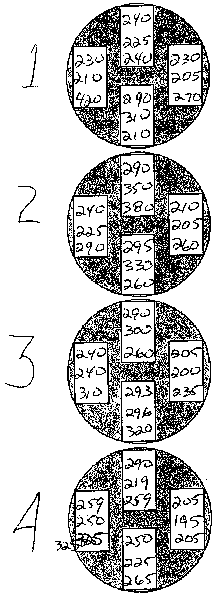 The image on the right shows the results from a sonic test of my own S14 2.3L cylinder block
(which had to be hot tanked before the test).
The numbers represent the wall thickness in 1/1000 inches. Thus a number of 240 means that the
block thickness at that location is 0.240". Sonic test measurements are taken at four locations
around the bore, and at three different depths (approximately the top, the middle and the bottom of the bore).
The image on the right shows the results from a sonic test of my own S14 2.3L cylinder block
(which had to be hot tanked before the test).
The numbers represent the wall thickness in 1/1000 inches. Thus a number of 240 means that the
block thickness at that location is 0.240". Sonic test measurements are taken at four locations
around the bore, and at three different depths (approximately the top, the middle and the bottom of the bore).
The measurements have to be examined carefully. Not every data point is a valid representation of the actual block thickness at that particular location. Sometimes a localized pit in the cylinder wall, or a flake of rust inside the water jacket can lead to a thickness measurement which is completely out of bed with the other measurements in the same vicinity. Such erroneous data points have to be filtered out in order to ascertain an average wall thickness in the region. To get a truly accurate map of the wall thickness around each cylinder would require that many more data points be measured and probably that each point be measured two or three times and the results averaged out. But this would be prohibitively expensive. All we are really trying to do here is figure out what a safe bore size is for a rebuild. It is important to remember how increasing the bore size will reduce the cylinder wall thickness. The "meat" between the cylinder bores will be reduced by an amount equal to the increase in bore size. However, the rest of the cylinder wall will only be reduced by half of the increase in bore size. For the results shown here an increase in the bore of 0.060" will yield a minimum wall thickness between bores of about 0.200" - 0.220". This same 0.060" increase in bore size will result in a minimum water jacket wall thickness of about 0.140", but only on the passenger side of bores #3 and #4 and even then only over a small portion of the bore (as opposed to all the way around the bore). It is instructive to consider exactly where block thickness is critical. It is also nice to compare sonic test data for at least two different blocks to see how they compare. For this we go to the next page » |